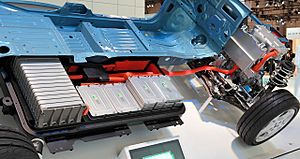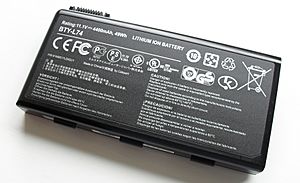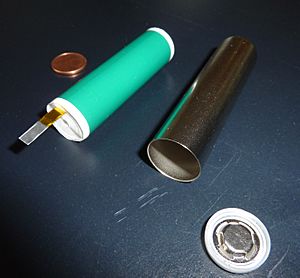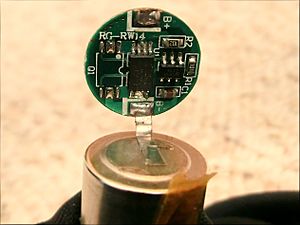Lithium-ion battery facts for kids
A lithium-ion battery is a lightweight, high-power battery used in computers and mobile phones. It comes in several shapes, although a flat rectangle is most common. It is lighter than the nickel cadmium battery and the nickel metal-hydride battery. That makes it useful for devices that should be lightweight. Lithium ion batteries work by the movement of lithium ions through a membrane (thin sheet that allows some substances to pass through).
They are different from lithium batteries. Lithium batteries contain lithium metal and are not rechargeable (primary cells). Lithium-ion batteries do not contain lithium metal and are rechargeable (secondary cells). They also do not last forever. Each lithium-ion battery will have an average of 600 charge cycles.
Contents
Construction
The three primary functional components of a lithium-ion battery are the positive and negative electrodes and electrolyte. Generally, the negative electrode of a conventional lithium-ion cell is made from carbon. The positive electrode is a metal oxide, and the electrolyte is a lithium salt in an organic solvent. The electrochemical roles of the electrodes reverse between anode and cathode, depending on the direction of current flow through the cell.
The most commercially popular negative electrode is graphite. The positive electrode is generally one of three materials: a layered oxide (such as lithium cobalt oxide), a polyanion (such as lithium iron phosphate) or a spinel (such as lithium manganese oxide). Recently, graphene based electrodes (based on 2D and 3D structures of graphene) have also been used as electrodes for lithium batteries.
The electrolyte is typically a mixture of organic carbonates such as ethylene carbonate or diethyl carbonate containing complexes of lithium ions.
Depending on materials choices, the voltage, energy density, life, and safety of a lithium-ion battery can change dramatically. Recently, novel architectures using nanotechnology have been employed to improve performance.
Pure lithium is highly reactive. It reacts vigorously with water to form lithium hydroxide and hydrogen gas. Thus, a non-aqueous electrolyte is typically used, and a sealed container rigidly excludes moisture from the battery pack.
Lithium-ion batteries are more expensive than NiCd batteries but operate over a wider temperature range with higher energy densities. They require a protective circuit to limit peak voltage.
For notebooks or laptops, lithium-ion cells are supplied as part of a battery pack with temperature sensors, voltage converter/regulator circuit, voltage tap, battery charge state monitor and the main connector. These components monitor the state of charge and current in and out of each cell, capacities of each individual cell (drastic change can lead to reverse polarities which is dangerous), and temperature of each cell and minimize the risk of short circuits.
Shapes

Li-ion cells (as distinct from entire batteries) are available in various shapes, which can generally be divided into four groups:
- Small cylindrical (solid body without terminals, such as those used in older laptop batteries)
- Large cylindrical (solid body with large threaded terminals)
- Pouch (soft, flat body, such as those used in cell phones and newer laptops; also referred to as li-ion polymer or lithium polymer batteries)
- Prismatic (semi-hard plastic case with large threaded terminals, such as vehicles' traction packs)
Cells with a cylindrical shape are made in a characteristic "swiss roll" manner (known as a "jelly roll" in the US), which means it is a single long sandwich of positive electrode, separator, negative electrode and separator rolled into a single spool. The main disadvantage of this method of construction is that the cell will have a higher series inductance.
The absence of a case gives pouch cells the highest gravimetric energy density; however, for many practical applications they still require an external means of containment to prevent expansion when their state-of-charge (SOC) level is high, and for general structural stability of the battery pack of which they are part.
Since 2011, several research groups have announced demonstrations of lithium-ion flow batteries that suspend the cathode or anode material in an aqueous or organic solution.
In 2014, Panasonic created the smallest Li-ion battery. It is pin shaped. It has a diameter of 3.5mm and a weight of 0.6g.
Images for kids
See also
 In Spanish: Batería de ion de litio para niños
In Spanish: Batería de ion de litio para niños






